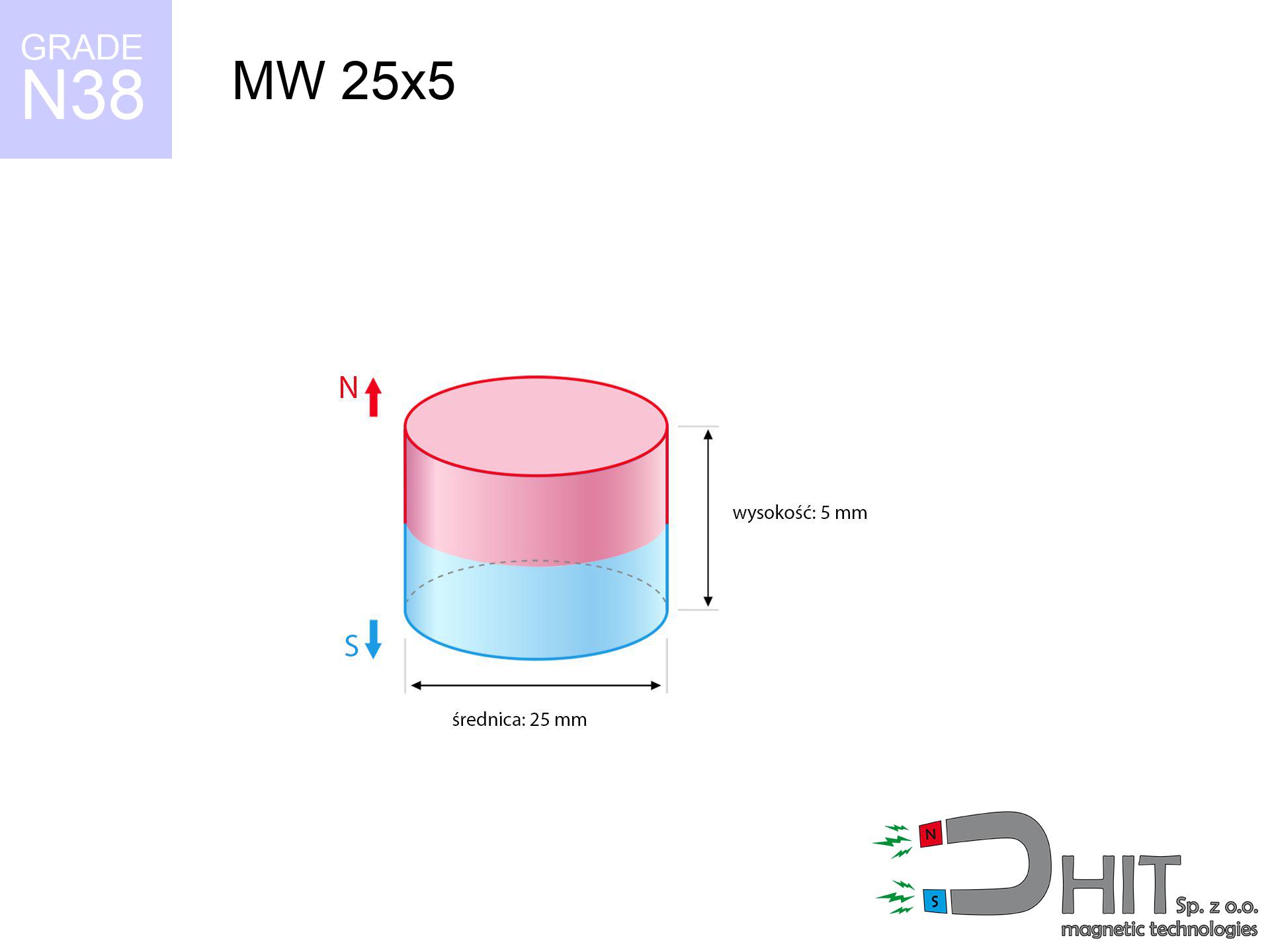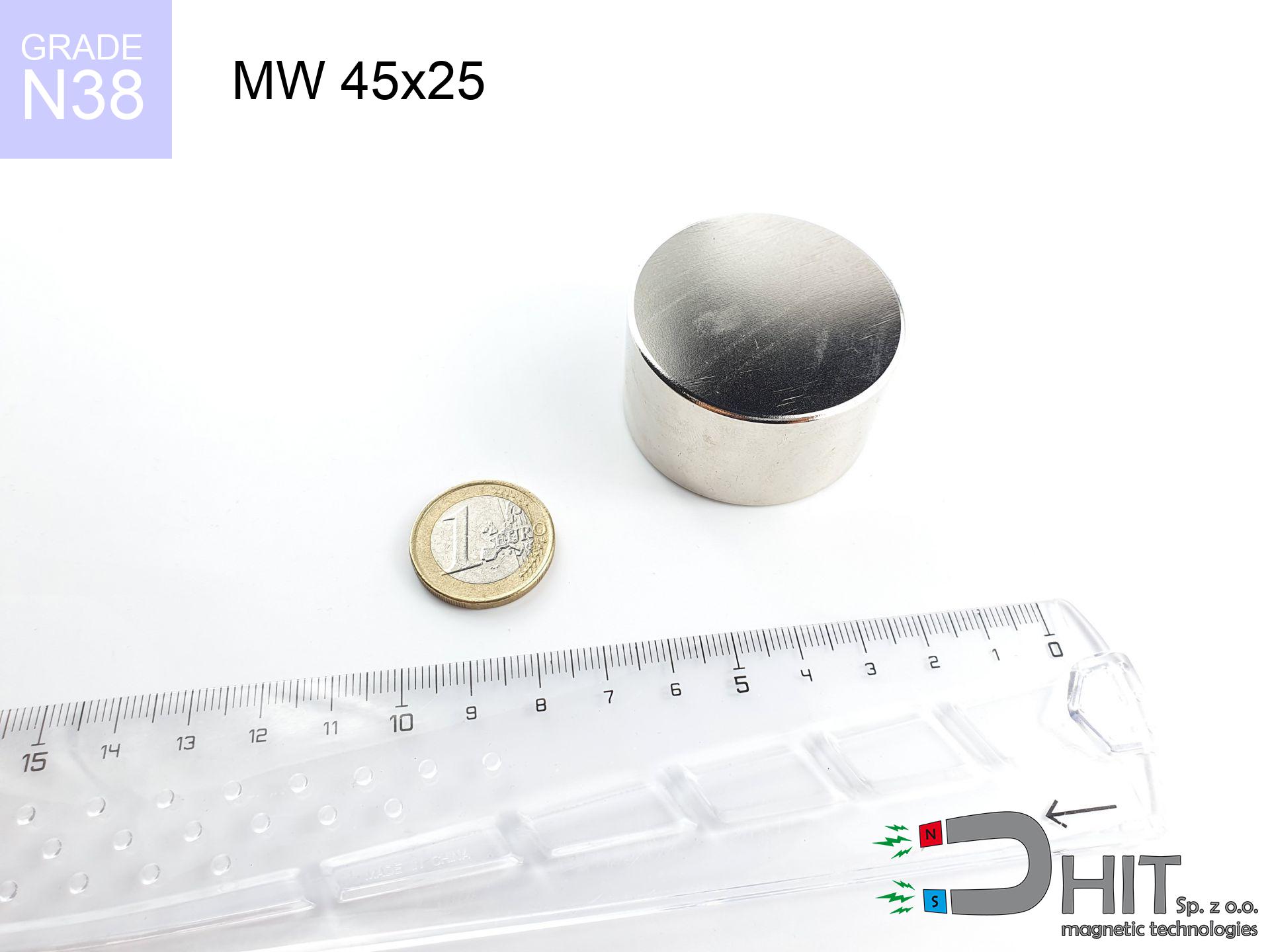MW 25x5 / N38 - neodymium magnet
cylindrical magnet
catalog number 010049
GTIN: 5906301810483
diameter Ø
25
mm [±0,1 mm]
height
5
mm [±0,1 mm]
magnetizing direction
↑ axial
capacity ~
6.91 kg / 67.76 N
magnetic induction ~
230.20 mT / 2,302 Gs
max. temperature
≤ 80
°C
catalog number 010049
GTIN: 5906301810483
diameter Ø
25 mm [±0,1 mm]
height
5 mm [±0,1 mm]
magnetizing direction
↑ axial
capacity ~
6.91 kg / 67.76 N
magnetic induction ~
230.20 mT / 2,302 Gs
max. temperature
≤ 80 °C
9.20 ZŁ gross price (including VAT) / pcs +
7.48 ZŁ net price + 23% VAT / pcs
bulk discounts:
need more quantity?Do you have a dilemma in choosing?
Give us a call tel: +48 22 499 98 98 or write via contact form on our website. You can check the mass and the shape of neodymium magnets in our force calculator magnetic calculator
Orders placed by 2:00 PM will be shipped on the same business day.
Specification: cylindrical magnet 25x5 / N38 ↑ axial
Magnetic properties of the material N38
Physical properties of sintered neodymium magnets Nd2Fe14B
Moreover, even though neodymium is part of the strongest magnets, they are susceptible to corrosion in humid environments. For this reason, they are coated with a thin layer of epoxy to protect them from corrosion. It's worth noting that NdFeB neodymium magnets are about 13% lighter than SmCo magnets and, despite their power, easily break, which requires special caution during their handling. For this reason, any mechanical processing should be done before they are magnetized.
In terms of safety, there are several recommendations regarding the use of these magnets. It is advisable to avoid their use in acidic, basic, organic environments or in solvents, and also in water or oil. Additionally, they can distort data on magnetic cards and hard drives, although data deletion using a neodymium magnet is not always certain.
In terms of properties in different environments, neodymium magnets are sensitive to corrosion, especially in humid conditions. Therefore, they are often covered with thin coatings, such as nickel, to protect them from environmental factors and prolong their durability. High temperatures exceeding 130°C can cause a deterioration of their magnetic strength, although there are specific types of neodymium magnets that can withstand temperatures up to 230°C.
As for dangers, it is important to avoid using neodymium magnets in acidic conditions, basic environments, organic or solvent environments, unless they are properly protected. Additionally, their use is not recommended in water, oil, or in an environment containing hydrogen, as they may forfeit their magnetic properties.
List recommended items
Advantages and disadvantages of neodymium magnets NdFeB.
Apart from immense power, neodymium magnets have the following advantages:
- They do not lose strength over time. After 10 years, their strength decreases by only ~1% (theoretically),
- They are extremely resistant to demagnetization by external magnetic sources,
- In other words, thanks to the shiny coating of nickel, gold, or silver, the element acquires an aesthetic appearance,
- They exhibit extremely high magnetic induction on the surface of the magnet,
- By using an appropriate combination of materials, they can achieve high thermal resistance, allowing them to operate at temperatures up to 230°C and above...
- The ability for precise shaping and customization to specific needs – neodymium magnets can be produced in various forms and dimensions, which expands the range of their possible uses.
- Significant importance in advanced technologically fields – are utilized in hard drives, electric drive mechanisms, medical devices and other modern machines.
Disadvantages of neodymium magnets:
- They can break when subjected to a powerful impact. If the magnets are exposed to impacts, we recommend using magnets in a steel housing. The steel housing in the form of a holder protects the magnet from impacts and at the same time increases its overall strength,
- They lose power at high temperatures. Most neodymium magnets experience permanent loss of strength when heated above 80°C (depending on the shape and height). However, we also offer special magnets with high temperature resistance, up to 230°C,
- Magnets exposed to a humid environment can corrode. Therefore, when using them outdoors, we suggest using waterproof magnets made of rubber, plastic, or other moisture-resistant materials,
- Limited ability to create threads or complex shapes in the magnet - the use of a housing is recommended - magnetic holder
- Potential hazard arising from small pieces of magnets can be dangerous, if swallowed, which becomes significant in the context of child safety. Additionally, tiny parts of these magnets have the potential to hinder the diagnostic process when they are in the body.
Handle Neodymium Magnets with Caution
If you have a nickel allergy, avoid contact with neodymium magnets.
Studies show a small percentage of people have allergies to certain metals, including nickel. An allergic reaction often manifests as skin redness and rash. If you have a nickel allergy, try wearing gloves or avoid direct contact with nickel-plated neodymium magnets.
Dust and powder from neodymium magnets are highly flammable.
Avoid drilling or mechanical processing of neodymium magnets. If the magnet is crushed into fine powder or dust, it becomes highly flammable.
People with pacemakers are advised to avoid neodymium magnets.
Neodymium magnets generate very strong magnetic fields that can interfere with the operation of a pacemaker. This happens because such devices have a function to deactivate them in a magnetic field.
Neodymium magnets are characterized by their fragility, which can cause them to crumble.
In the event of a collision between two neodymium magnets, it can result in them getting chipped. Despite being made of metal and coated with a shiny nickel plating, they are not as hard as steel. At the moment of connection between the magnets, small sharp metal pieces can be propelled in various directions at high speed. Eye protection is recommended.
Keep neodymium magnets far from children.
Remember that neodymium magnets are not toys. Be cautious and make sure no child plays with them. They can be a significant choking hazard. If multiple magnets are swallowed, they can attract to each other through the intestinal walls, causing significant injuries, and even death.
Magnets will attract to each other, so remember not to allow them to pinch together without control or place your fingers in their path.
Magnets will crack or alternatively crumble with careless connecting to each other. Remember not to approach them to each other or hold them firmly in hands at a distance less than 10 cm.
Keep neodymium magnets away from GPS and smartphones.
Magnetic fields can interfere with compasses and magnetometers used in aviation and maritime navigation, as well as internal compasses of smartphones and GPS devices. There are neodymium magnets in every smartphone, for example, in the microphone and speakers.
Neodymium magnets can demagnetize at high temperatures.
Although magnets have shown to retain their effectiveness up to 80°C or 175°F, this temperature may vary depending on the type of material, shape, and intended use of the magnet.
Keep neodymium magnets away from TV, wallet, and computer HDD.
Strong fields generated by neodymium magnets can damage magnetic storage media such as floppy disks, credit cards, magnetic ID cards, cassette tapes, video tapes, or other similar devices. They can also damage televisions, VCRs, computer monitors, and CRT displays. You should especially avoid placing neodymium magnets near electronic devices.
Neodymium magnets are the strongest, most remarkable magnets on earth, and the surprising force between them can shock you at first.
To handle magnets properly, it is best to familiarize yourself with our information beforehand. This will help you avoid significant harm to your body and the magnets themselves.
Please read the article - What danger lies in neodymium magnets? You will learn how to handle them properly.




![magnetic holder internal thread 32x18x8 [M6] GW / N38 magnetic holder internal thread 32x18x8 [M6] GW / N38](https://cdn3.dhit.pl/graphics/products/um32x18x8-m6-gw--hec.jpg)
![search holder 75x25 [M10x3] GW F200 PLATINIUM Lina / N52 search holder 75x25 [M10x3] GW F200 PLATINIUM Lina / N52](https://cdn3.dhit.pl/graphics/products/ump-75x25-m10x3-gw-f200-platinium-lina-wiz.jpg)

![magnetic holder internal thread 75x33x18 [M10] GW / N38 magnetic holder internal thread 75x33x18 [M10] GW / N38](https://cdn3.dhit.pl/graphics/products/umgw-75x33x18-m10-gw-cak.jpg)

